Abstract
This study, an important groundwork for clinical tongue diagnosis and future traditional Chinese medicine (TCM) research, tested the hypothesis that some tongue features vary significantly between different gender and age groups by utilizing an automatic tongue diagnosis system (ATDS).
A cross-sectional study of 1487 participants from a community-based population was performed. Study subjects with ages ranging from 20 to 92 were categorized into 3 groups: <40, 40 to 64, and ≥65 years old, and the subjects were also stratified according to gender. Tongue images were collected at the end of each normal health examination routine to further derive the relevant tongue features of every participant by using the ATDS developed by our team. There were a total of nine tongue features that were identified: tongue shape, tongue color, fur thickness, fur color, saliva, tongue fissure, ecchymosis, teeth mark, and red dot. The corresponding tongue features, demography, and physical/laboratory examination data were compared between different gender and age groups.
Our study showed that, compared to females, males had enlarged tongue shape, thicker fur, more fissures and fewer teeth marks (all P < .001), and also had more red tongue color (P = .019), normal saliva (P = .001), more red dots (P = .005) and yellower fur (P = .014). In females, increasing age was associated with more enlarged tongue shape, thicker fur, yellower fur, more saliva, fissures and fewer teeth marks (all P < .001), more ecchymoses (P = .009), and more red tongue color (P = .023). These associations of age with more fissures, fewer teeth marks, fewer red dots (P < .001), median tongue shape (P = .029), and wet saliva (P = .014) were also evident in males, but other relationships were not clearly evident.
Even though most of the common tongue features derived from a community-based population are consistent with TCM theory, yet some significantly gender- and age-dependent tongue characteristics were identified. These disparities in tongue features associated with gender or age shall be prudently taken into consideration in clinical tongue diagnosis and future TCM research.
Keywords: automatic tongue diagnosis system (ATDS), community-based population, tongue features, Traditional Chinese medicine (TCM)
1. Introduction
Traditional Chinese medicine (TCM) has received a wider acceptance from western medicine in recent years.[1] The World Health Organization (WHO) even published a dictionary-type book which covers thousands of Traditional Medicine terms from basic theories, diagnostics, diseases, various therapeutics.[2] TCM diagnosis is based on four standard approaches, i.e., inspection, smelling/listening, inquiry, and palpation. Inspection tops the four ways of TCM diagnosis and the tongue is the major subject of focus during inspection. Therefore, tongue diagnosis, serving as a common non-invasive means to reliably provide clinical information, plays a pivotal role in TCM.[3–14] By observing tongue features, TCM practitioners could probe into the status of blood and qi, and the alternation between yin and yang energies.[15,16]
In the past few years, several researches applied case-control methodology to explore the association between tongue characteristics and specific diseases, including breast cancer,[4,6] type 2 diabetes,[7,8] metabolic syndrome[9] and functional dyspepsia,[17] in the hope of deriving discriminating tongue features to distinguish individuals with/without the specific disease through a non-invasive means in the early stage. However, the physiological phenomenon of the human body may vary among different gender and age groups, e.g., the female constitution is subject to change due to menopause,[18,19] or pregnancy,[20,21] and ageing could cause physiological changes.[22,23] Even though a pinkish tongue with thin layer of white fur, normal amount of saliva, and no visible fissure, ecchymosis, teeth mark and red dot present is widely recognized as observed in an average person, some tongue features might progressively deviate from this norm through aging or digress between males and females due to inherently dissimilar constitution. In the absence of full knowledge of the progressive changes of tongue features through different stages of life and fundamental disparities between genders, the discriminating tongue index identifying a specific disease aforementioned might prove to be biased and results will be rendered inconclusive.
In light of the above observation, we speculate that some tongue features might vary among different gender and age groups. Besides, the inconsistency of subjective diagnosis can be improved by using the development of validated instruments. An automatic tongue diagnosis system (ATDS), with a high degree of diagnostic consistency, was developed by our team.[24,25] With the help of ATDS, the study was tested by performing a cross-sectional tongue diagnosis study from a community-based population with 1,487 participants to explore tongue features between different age groups and genders.
2. Methods
2.1. Study design and participants
In order to derive representative values/ranges of a specific group of population, data collected from health examinations or community surveys are often employed.[17,26] In this study, subjects who were older than 20 years old with signed consent, while undergoing health examination at Changhua Christian Hospital, Taiwan, were recruited from September 2014 to September 2016. Information including demography, physical examination (height, weight, body mass index (BMI), systolic and diastolic blood pressure, and heart rate), and blood test (fasting blood-glucose level, cholesterol and triglyceride) were gathered for each subject. Tongue images were collected at the end of each normal health examination routine to further derive the relevant tongue features of every participant.
-
Inclusion Criteria. Participants meeting the following criteria would be included:
-
(1)
Age above 20 years old
-
(2)
Complete tongue diagnosis data
-
(3)
Signed IRB agreement in joining this study.
-
(1)
-
Exclusion Criteria. Participants meeting one or more of the following criteria would be excluded:
-
(1)
Not signed IRB agreement
-
(2)
Unstable vital sign or unconsciousness
-
(3)
Unable to open mouth or risk of jaw dislocation
-
(4)
Unable to protrude tongue or with insufficient length protruded to allow capturing of tongue image
-
(5)
Cognitive impairment or unable to communicate
-
(6)
With acute infection, tongue or oral cancer.
-
(1)
A total of 1487 participants were recruited in our study. All personal details and photographs of recruited subjects were encrypted to ensure confidentiality.
This study was approved by the Institutional Review Board of Changhua Christian Hospital, Taiwan (IRB Number: 140704), and we confirm that all methods were performed in accordance with relevant guidelines and regulations. All subjects have provided written informed consent prior to participating in the study.
2.2. ATDS and tongue features
Observation diagnosis is often biased by subjective judgment, which originates from personal experience, knowledge, diagnostic skills, thinking patterns, and color perception/interpretation. A practitioner may reach inconsistent diagnoses on the same tongue if it is examined at different time. In addition, different practitioners may pass disparate judgments on an identical tongue. The ATDS was developed by our team to capture tongue images and automatically extract features consistently to assist the diagnosis of TCM practitioners (Figs. 1 and 2).[25,27,28] The value of ATDS hinges on its ability to calibrate brightness and color to compensate for its variations in intensity and color temperatures from light sources and imaging hardware. It also segments the tongue region and extracts the tongue features automatically. There are nine primary features for TCM clinical tongue diagnosis: tongue shape, tongue color, fur thickness, fur color, saliva, tongue fissure, ecchymosis, teeth mark, and red dot (Fig. 1).
Figure 1.
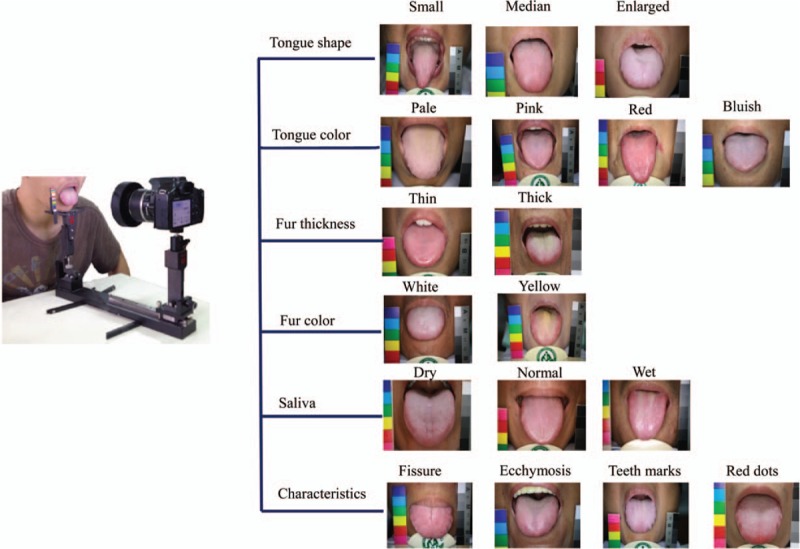
Image acquisition through the Automatic Tongue Diagnosis System, ATDS.
Figure 2.
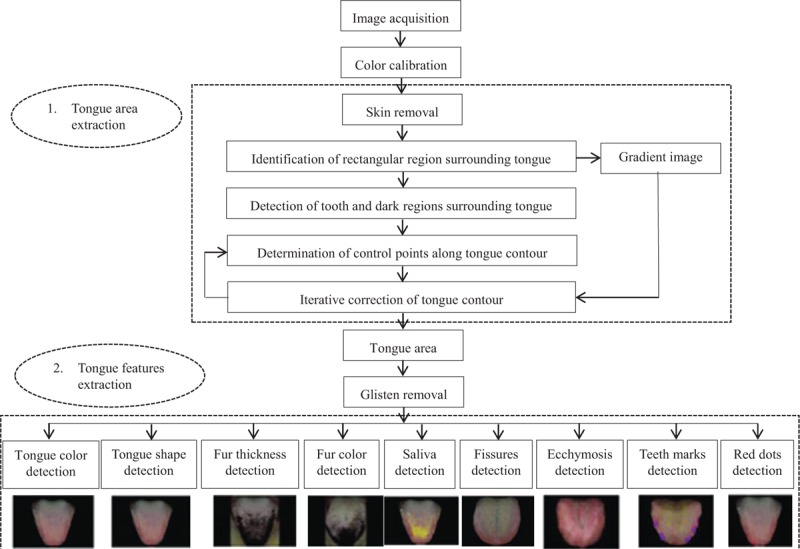
The processing flow of ATDS analysis.
These features are extracted by ATDS to further generate detailed information regarding length, area, moisture, and number of relevant tongue features. Our team synthesized the experience of tongue diagnosis of TCM practitioners and multiple professional opinions, we defined the parameters of different tongue features classifications in ATDS to classify.
A listing of the tongue features extracted is summarized below:
-
1.
Tongue shape: small, median, and enlarged
-
2.
Tongue color: pale, pink, red, and bluish
-
3.
Fur thickness: thin or thick
-
4.
Fur color: no fur, white, yellow, and others
-
5.
Saliva: normal or wet
-
6.
Characteristics: numbers of tongue fissures, ecchymoses, teeth marks and red dots
2.3. Data analysis
The data were expressed as mean ± standard deviation (SD), percentage, or number where appropriate. The tongue features in different age or gender groups were analyzed and compared using the independent t test or Mann–Whitney U test for continuous variables. Furthermore, a non-parametric test (Jonckheere-Terpstra test) was applied to compare the level of age in males and females. Statistical analysis was performed using SPSS statistical software for Windows version 19 (SPSS for Windows, version 19; SPSS Inc., Chicago, IL) and Statistical Analysis System (SAS) 9.4. A P value <.05 was considered statistically significant.
3. Results
3.1. Characteristics of the study participants
A total of 1487 subjects, ranging from ages 20 to 92, were recruited in this study. Among them, 44.3% were males (659 participants) and 55.7% were females (828 participants). As shown in Table 1, the average age was 54.7 ± 18.3 years old; mean BMI 23.7 ± 3.7 kg/m2, mean blood pressure 126.1 ± 18.2 (systolic) /77.2 ± 10.3 (diastolic) mmHg, mean fasting sugar level and lipid profile within normal range, and the values of both genders were also displayed separately. The participants were categorized into 2 age groups (<65 years old and ≥65 years old), which were then further stratified based on gender to facilitate the derivation of representative tongue features at different age and gender groups.
Table 1.
Characteristics of study participants.
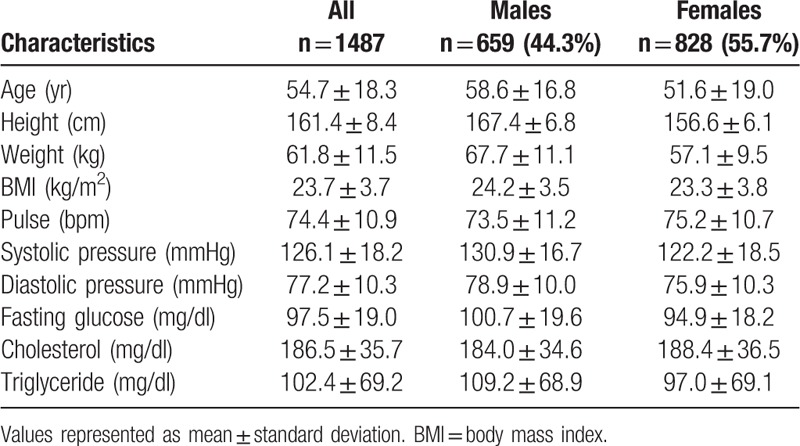
3.2. Common tongue features from a community-based population
Tongue inspection refers to the examination of prominent tongue features, which include body shape, tongue color, fur color, fur thickness, saliva, etc. Among the 1487 subjects, the most common tongue features were median tongue shape (57.8%), pink tongue color (59.7%), thick fur (58.6%), white fur color (59.8%), and normal saliva (78.6%) in separate categories, respectively. In fur color category “others” refers to dyeing or black, which is rare during clinical diagnosis and therefore not included in the analysis. The mean numbers of fissures, ecchymoses, teeth marks, and red dots extracted in the total population were 6.1 ± 7.9, 5.1 ± 8.4, 3.1 ± 2.7, and 79.9 ± 67.4, respectively (Table 2).
Table 2.
Comparison of tongue features between genders.
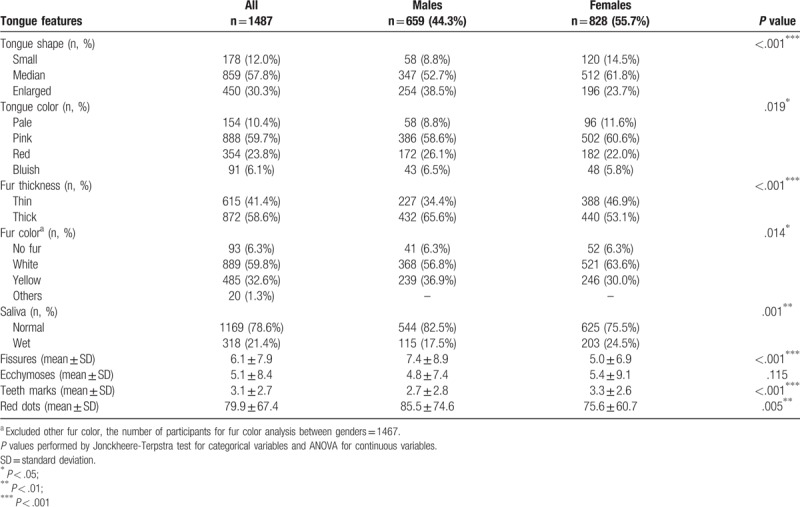
3.3. Differences of tongue features between genders
The tongue features were further examined to address the disparities present between the different genders. Compared to females, males had enlarged tongue shape, thicker fur, more fissures and fewer teeth marks (all P < .001), and also had more red tongue color (P = .019), normal saliva (P = .001), more red dots (P = .005) and yellower fur (P = .014). No significant difference in ecchymosis between males and females was found (Table 2).
3.4. Differences of tongue features among different age groups
The relationship between age and tongue features was tabulated for males and females in, respectively. These associations of age with more fissures, fewer teeth marks, fewer red dots (P < .001), median tongue shape (P = .029), and wet saliva (P = .014) were also evident in males, but other relationships were not clearly evident. In females, elderly age was associated with more enlarged tongue shape, thicker fur, yellower fur, more saliva, fissures and fewer teeth marks (all P < .001), more ecchymoses (P = .009), and more red tongue color (P = .023).
Table 3.
Tongue features among different male age groups (n = 659).
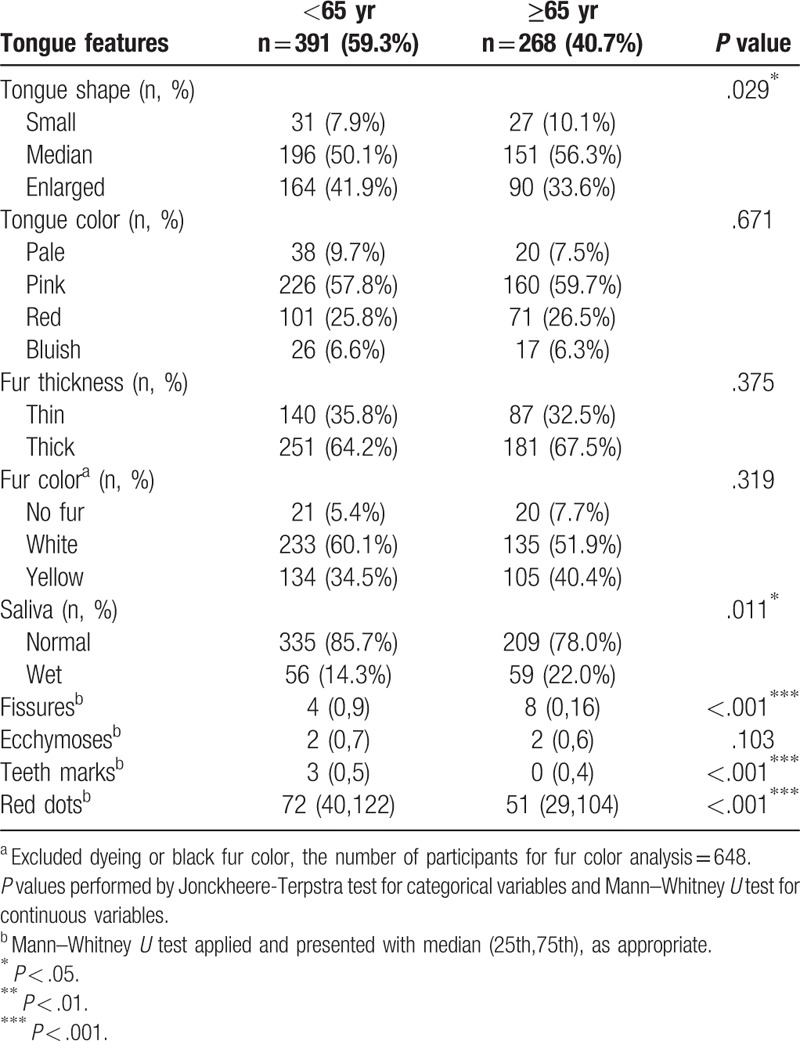
Table 4.
Tongue features among different female age groups (n = 828).
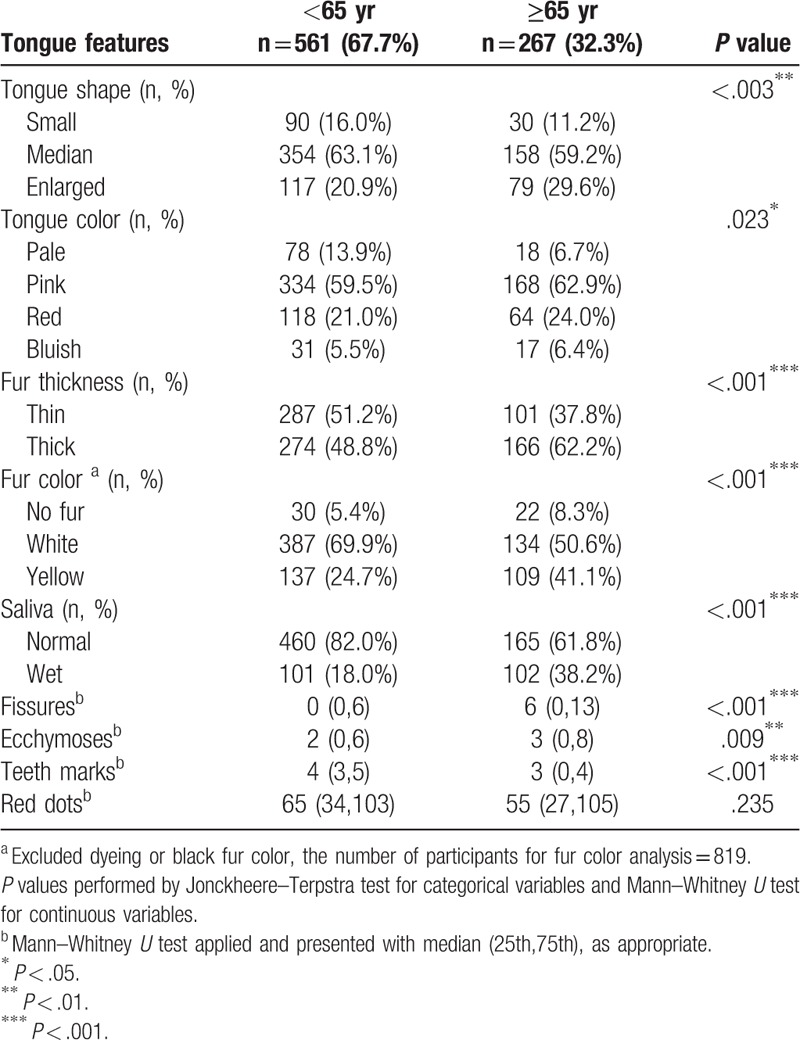
4. Discussion
To the best of our knowledge, this is the first study to investigate the association between tongue features and gender/age in a community-based population. The tongue appearance is a crucial indicator in the TCM assessment.[16] Tongue inspection refers to visual evaluation of the shape, color, and fur color, fur thickness, and other tongue characteristics.[29] In the past few years, there were many reports regarding the relationship between tongue features and specific diseases. For example, thin fur was less likely to be found in patients with early-stage breast cancer than non-breast cancer individuals[6]; a higher proportion of white fur and a lower proportion of yellow fur were present in metabolic syndrome group[9]; ecchymosis in patients with type 2 diabetes corresponded significantly to arterial stiffness.[7] There were also studies that explored the relationship between various types of stroke and tongue features.[11,12,30] In order to objectively study the progressive changes of tongue features through different stages of life and the fundamental disparities between genders, a large sample size with 1487 test subjects were recruited to identify tongue features that are invariant to the discrepancies in both age and sex. The results showed that the physiological condition of the participant was in accordance with normal standards.
A normal tongue pattern has been long recognized as median tongue shape, pink-color tongue, thin fur with white fur color and normal saliva.[16] Our study has shown that the most common tongue features were median tongue shape (57.8%), pink tongue color (59.7%), white fur color (59.8%) and normal saliva (78.6%), which consistently agrees with both the TCM theory and previous studies.[31,32] Interestingly, we discovered that the proportion of thick fur was higher than the proportion of thin fur. This might be attributed to the fact that the average age of subjects (54.7 ± 18.3 years old) in this study was higher. With the increase of age, the function of body organs gradually degenerates, and it is often associated with thick tongue fur.[33,34]
Some tongue features might digress between males and females due to their inherently dissimilar constitution. It is both interesting and enlightening to identify the invariant tongue features that are unaffected by gender and the non-uniform ones which are disparate due to gender differences. In the different cross-examined age groups, more changes of tongue features were detected in females than in the males counterparts. According to the most important ancient book of Chinese medicine “Huangdi Neijing” females have a basic 7-year cycle, while males an eight-year one. At every age and period, the body changes in accordance with the relative strength or weakness of an individual's kidney essence and kidney qi, which leads different physiological changes and states.[35] Furthermore, females would experience menopause once they reach middle age. During this time, the female constitution would gradually begin to change, such as the endocrine system,[36] blood circulation,[37] and autonomic nerves,[38,39] which in turn might further impact on the characteristics of tongue.
Although there were many findings in the relationship between gender, age, and tongue features, the underlying mechanisms regarding how gender and age affected tongue features are yet to be clarified. More basic researches, from the expressions of apoptosis-related genes of the tongue epithelial cells to microbiological effects, are needed to establish the exact models.[28,40,41] This study serves as an important groundwork to identify tongue features that varying significantly between different gender and age groups, and this is indispensable for clinical tongue diagnosis and future TCM research.
This is the first study to apply TCM tongue diagnosis to investigate the association of gender, age and tongue features in a community-based population by using the ATDS. The high agreement of the ATDS can provide objective and reliable tongue features to facilitate doctors in making effective observation and diagnosis.[25] However, there were limitations in our study. In the community-based population targeted study, some participants might have comorbidity diseases. These comorbidities may affect the tongue appearance and the features extracted, and further distort the statistical results. In future work, the association between comorbidity or specific disease and tongue features will be explored.
5. Conclusion
This study showed most of the common tongue features, which were derived from a community-based population included median tongue shape, pink tongue color, white fur color, and normal saliva. Some tongue features, significantly gender- and age-dependent, were identified. These disparities in tongue features from different gender and age groups shall be prudently taken into consideration in clinical practice and future TCM research to reach correct tongue diagnosis.
Acknowledgments
The authors are grateful to the anonymous reviewers for their valuable comments.
Author contributions
Conceptualization: Han-Kuei Wu, Yu-Chuen Huang, Hen-Hong Chang, Lun-Chien Lo.
Formal analysis: Yi-Ping Chen.
Methodology: Po-Chi Hsu, Lun-Chien Lo.
Supervision: Yu-Chuen Huang, John Y. Chiang, Lun-Chien Lo.
Writing – original draft: Po-Chi Hsu, Yi-Ping Chen.
Writing – review & editing: Yu-Chuen Huang, John Y. Chiang.
Footnotes
Abbreviations: ATDS = automatic tongue diagnosis system, BMI = body mass index, SD = standard deviation, TCM = Traditional Chinese medicine.
How to cite this article: Hsu PC, Wu HK, Huang YC, Chang HH, Chen YP, Chiang JY, Lo LC. Gender- and age-dependent tongue features in a community-based population. Medicine. 2019;98:51(e18350).
All candidates received a standardized interview process. Participants were introduced to the purpose, procedures, potential risks and benefits of the study first, and signed the informed consent form. This study was approved by the Institutional Review Board of Changhua Christian Hospital, Taiwan (institutional review board reference number: 140704).
The authors would like to thank the Ministry of Health and Welfare (MOHW103-CMAP-M-114-000416, MOHW104-CMAP-M-114-123405, MOHW105-CMAP-M-114-133402, and MOHW108-TDU-B-212-133004), Ministry of Science and Technology of Taiwan (MOST 107-2320-B-039-068), China Medical University (CMU107-N-29) and China Medical University Hospital (CRS-108-004) for the grant support, and Dr. Yun-Tai Chen, Dr. Jia-Ming Chen, Miss Li-Jyun Deng, and all of the colleagues who helped contribute to this study.
The authors declare no conflicts of interests.
References
- [1].Cyranoski D. Why Chinese medicine is heading for clinics around the world. Nature 2018;561:448–50. [DOI] [PubMed] [Google Scholar]
- [2].Organization WH. WHO international standard terminologies on traditional medicine in the western pacific region. In: Manila: WHO Regional Office for the Western Pacific; 2007. [Google Scholar]
- [3].Lo LC, Chen CY, Chiang JY, et al. Tongue diagnosis of traditional Chinese medicine for rheumatoid arthritis. Afr J Tradit Complement Altern Med 2013;10:360–9. [DOI] [PMC free article] [PubMed] [Google Scholar]
- [4].Lo LC, Cheng TL, Chiang JY, et al. Breast cancer index: a perspective on tongue diagnosis in traditional chinese medicine. J Tradit Complement Med 2013;3:194–203. [DOI] [PMC free article] [PubMed] [Google Scholar]
- [5].Liao PY, Hsu PC, Chen JM, et al. Diabetes with pyogenic liver abscess--A perspective on tongue assessment in traditional Chinese medicine. Complement Ther Med 2014;22:341–8. [DOI] [PubMed] [Google Scholar]
- [6].Lo LC, Cheng TL, Chen YJ, et al. TCM tongue diagnosis index of early-stage breast cancer. Complement Ther Med 2015;23:705–13. [DOI] [PubMed] [Google Scholar]
- [7].Hsu PC, Huang YC, Chiang JY, et al. The association between arterial stiffness and tongue manifestations of blood stasis in patients with type 2 diabetes. BMC Complement Altern Med 2016;16:324. [DOI] [PMC free article] [PubMed] [Google Scholar]
- [8].Hsu PC, Wu HK, Huang YC, et al. The tongue features associated with type 2 diabetes mellitus. Medicine (Baltimore) 2019;98:e15567. [DOI] [PMC free article] [PubMed] [Google Scholar]
- [9].Lee TC, Lo LC, Wu FC. Traditional Chinese Medicine for Metabolic Syndrome via TCM Pattern Differentiation: Tongue Diagnosis for Predictor. Evid Based Complement Alternat Med 2016;2016:1971295. [DOI] [PMC free article] [PubMed] [Google Scholar]
- [10].Huang YS, Sun MC, Hsu PC, et al. The Relationship between Ischemic Stroke Patients with and without Retroflex Tongue: A Retrospective Study. Evid Based Complement Alternat Med 2017;2017:3195749. [DOI] [PMC free article] [PubMed] [Google Scholar]
- [11].Gao L, Liu P, Song JX, et al. A pilot study on the relationship between tongue manifestation and the degree of neurological impairment in patients with acute cerebral infarction. Chin J Integr Med 2013;19:149–52. [DOI] [PubMed] [Google Scholar]
- [12].Liu P, Gao L, Song JX, et al. A pilot study on the correlation of tongue manifestation with the site of cerebral infarction in patients with stroke. Chin J Integr Med 2014;20:823–8. [DOI] [PubMed] [Google Scholar]
- [13].Feng Y, Xu H, Qu D, et al. Study on the tongue manifestations for the blood-stasis and toxin syndrome in the stable patients of coronary heart disease. Chin J Integr Med 2011;17:333–8. [DOI] [PubMed] [Google Scholar]
- [14].Yu Z, Zhang H, Fu L, et al. Objective research on tongue manifestation of patients with eczema. Technology and health care: official journal of the European Society for Engineering and Medicine 2017;25(S1):143–9. [DOI] [PubMed] [Google Scholar]
- [15].Kirschbaum B. Atlas of Chinese tongue diagnosis. Vol 1: Eastland Press Seattle; 2000. [Google Scholar]
- [16].Anastasi JK, Currie LM, Kim GH. Understanding diagnostic reasoning in TCM practice: tongue diagnosis. Altern Ther Health Med 2009;15:18–28. [PubMed] [Google Scholar]
- [17].Kim J, Han G, Ko SJ, et al. Tongue diagnosis system for quantitative assessment of tongue coating in patients with functional dyspepsia: a clinical trial. J Ethnopharmacol 2014;155:709–13. [DOI] [PubMed] [Google Scholar]
- [18].Singh GM, Danaei G, Pelizzari PM, et al. The age associations of blood pressure, cholesterol, and glucose: analysis of health examination surveys from international populations. Circulation 2012;125:2204–11. [DOI] [PMC free article] [PubMed] [Google Scholar]
- [19].Kuo TB, Lin T, Yang CC, et al. Effect of aging on gender differences in neural control of heart rate. Am J Physiol 1999;277(6 Pt 2):H2233–2239. [DOI] [PubMed] [Google Scholar]
- [20].Song JE, Chae HJ, Kim CH. Changes in perceived health status, physical symptoms, and sleep satisfaction of postpartum women over time. Nurs Health Sci 2014;16:335–42. [DOI] [PubMed] [Google Scholar]
- [21].Cho GJ, Yoon HJ, Kim EJ, et al. Postpartum changes in body composition. Obesity (Silver Spring, Md) 2011;19:2425–8. [DOI] [PubMed] [Google Scholar]
- [22].Tikhonova IV, Tankanag AV, Chemeris NK. Physiological features of skin ageing in human. Uspekhi Fiziologicheskikh Nauk 2013;44:85–92. [PubMed] [Google Scholar]
- [23].Weinstein JR, Anderson S. The aging kidney: physiological changes. Adv Chronic Kidney Dis 2010;17:302–7. [DOI] [PMC free article] [PubMed] [Google Scholar]
- [24].Jung CJ, Jeon YJ, Kim JY, et al. Review on the current trends in tongue diagnosis systems. Integr Med Res 2012;1:13–20. [DOI] [PMC free article] [PubMed] [Google Scholar]
- [25].Lo LC, Chen YF, Chen WJ, et al. The Study on the Agreement between Automatic Tongue Diagnosis System and Traditional Chinese Medicine Practitioners. Evid Based Complement Alternat Med 2012;2012:505063. [DOI] [PMC free article] [PubMed] [Google Scholar]
- [26].Steffen TM, Hacker TA, Mollinger L. Age- and gender-related test performance in community-dwelling elderly people: six-minute walk test, berg balance scale, timed up; go test, and gait speeds. Phys Therap 2002;82:128–37. [DOI] [PubMed] [Google Scholar]
- [27].Lo LC, Chen YF, Chiang JY, et al. Education of Chinese medicine tongue diagnosis by automatic tongue diagnosis system. Chin J Integr Med 2015;1:1–0. [DOI] [PubMed] [Google Scholar]
- [28].Hsu YC, Chen YC, Lo LC, et al. Automatic tongue feature extraction. Paper presented at: Computer Symposium (ICS), 2010 International. 2010. [Google Scholar]
- [29].Lo LC, Chiang JY, Cheng TL, et al. Visual agreement analyses of traditional chinese medicine: a multiple-dimensional scaling approach. Evid Based Complement Alternat Med 2012;2012:516473. [DOI] [PMC free article] [PubMed] [Google Scholar]
- [30].He MQ, Liu L, Ma J, et al. Risk factors and clinical features in ischemic stroke patients with different tongue conditions. Chin J Integr Med 2016;1–9. [DOI] [PubMed] [Google Scholar]
- [31].Wang HH, Pan CH, Wu PP, et al. Alteration of the tongue manifestation reflects clinical outcomes of peptic ulcer disease. J Altern Complement Med (New York, NY) 2012;18:1038–44. [DOI] [PMC free article] [PubMed] [Google Scholar]
- [32].Han S, Yang X, Qi Q, et al. Potential screening and early diagnosis method for cancer: Tongue diagnosis. Int J Oncol 2016;48:2257–64. [DOI] [PMC free article] [PubMed] [Google Scholar]
- [33].Zhang Y, Liu Y, Li X, et al. Age-related changes in prevalence and symptom characteristics in kidney deficiency syndrome with varied health status: a cross-sectional observational study. J Tradl Chin Med Sci 2014;1:20–7. [DOI] [PMC free article] [PubMed] [Google Scholar]
- [34].Dong Y, Ding Y, Liu PZ, et al. Investigation of the material basis underlying the correlation between presbycusis and kidney deficiency in traditional Chinese Medicine via GC/MS metabolomics. Evid Based Complement Alternat Med 2013;2013:762092. [DOI] [PMC free article] [PubMed] [Google Scholar]
- [35].Scheid V. Traditional Chinese medicine--what are we investigating? The case of menopause. Complement Ther Med 2007;15:54–68. [DOI] [PMC free article] [PubMed] [Google Scholar]
- [36].Chahal HS, Drake WM. The endocrine system and ageing. J Pathol 2007;211:173–80. [DOI] [PubMed] [Google Scholar]
- [37].Hirokawa K, Nagayoshi M, Ohira T, et al. Menopausal status in relation to cardiovascular stress reactivity in healthy Japanese participants. Psychosom Med 2014;76:701–8. [DOI] [PubMed] [Google Scholar]
- [38].Barnes JN, Hart EC, Curry TB, et al. Aging enhances autonomic support of blood pressure in women. Hypertension (Dallas, Tex: 1979) 2014;63:303–8. [DOI] [PMC free article] [PubMed] [Google Scholar]
- [39].Vongpatanasin W. Autonomic regulation of blood pressure in menopause. Semin Reprod Med 2009;27:338–45. [DOI] [PubMed] [Google Scholar]
- [40].Wu Z, Li M, Zhang Y, et al. Study on relationship between the thickness of tongue fur and the expressions of apoptosis-related genes of the tongue epithelial cells in patients with diseases of the digestive system. J Tradit Chin Med 2007;27:148–52. [PubMed] [Google Scholar]
- [41].Ye J, Cai X, Yang J, et al. Bacillus as a potential diagnostic marker for yellow tongue coating. Sci Rep 2016;6:32496. [DOI] [PMC free article] [PubMed] [Google Scholar]


